Investigating Shadow Banking's Role in Housing Market Affordability
VerifiedAdded on 2023/06/03
|33
|9430
|103
Thesis and Dissertation
AI Summary
This thesis project investigates the role of shadow banking in the context of housing market affordability in Australia. The research begins with an introduction outlining the research title, background, aims, objectives, and research questions. A comprehensive literature review explores the concept of shadow banking, determinants of housing market affordability, and the impact of shadow banking. The methodology or empirical strategy is then presented. The thesis further delves into the results and data analysis, followed by a conclusion summarizing the key findings and implications. The research aims to provide insights into the relationship between shadow banking and housing affordability, particularly in the context of the Australian residential market. The research also aims to identify the ramifications to the housing market in a more liberated credit access environment. It also discusses the impact of shadow banking on housing affordability for first-home buyers (FHB) in Australia. The study is structured to understand the meaning of key concepts, the determinants of housing market affordability, and the impact of shadow banking on the Australian housing market.
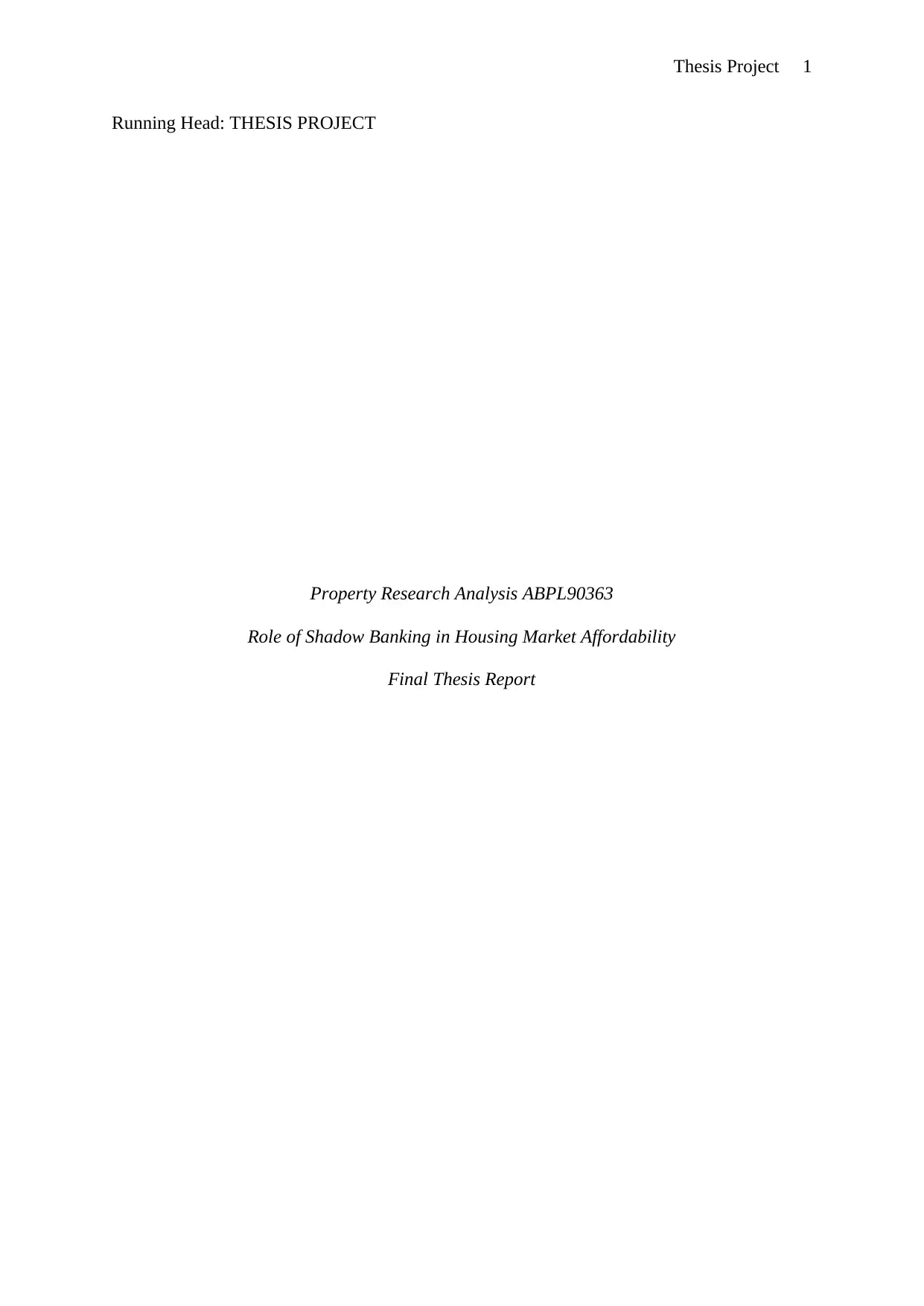
Thesis Project 1
Running Head: THESIS PROJECT
Property Research Analysis ABPL90363
Role of Shadow Banking in Housing Market Affordability
Final Thesis Report
Running Head: THESIS PROJECT
Property Research Analysis ABPL90363
Role of Shadow Banking in Housing Market Affordability
Final Thesis Report
Paraphrase This Document
Need a fresh take? Get an instant paraphrase of this document with our AI Paraphraser
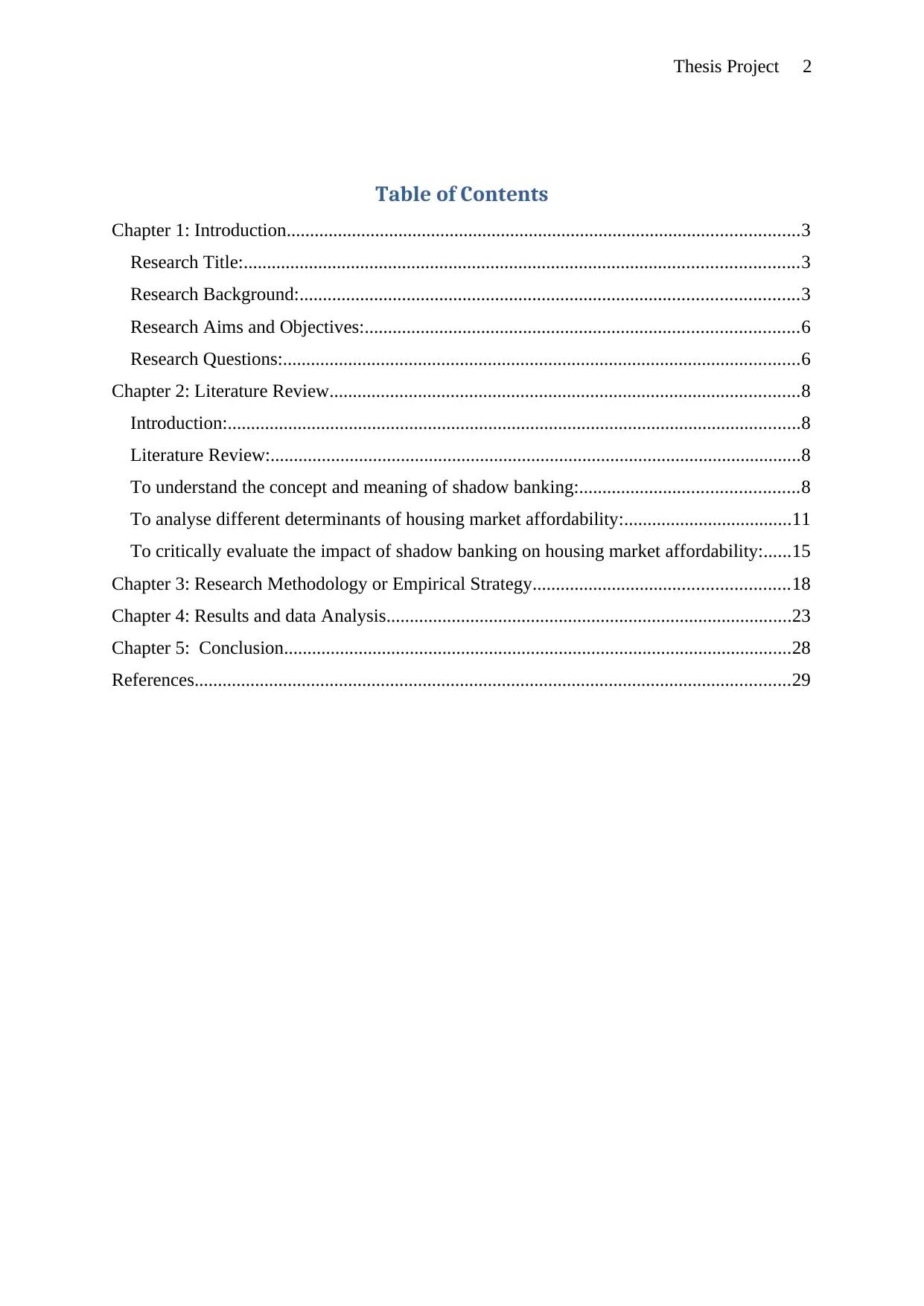
Thesis Project 2
Table of Contents
Chapter 1: Introduction..............................................................................................................3
Research Title:.......................................................................................................................3
Research Background:...........................................................................................................3
Research Aims and Objectives:.............................................................................................6
Research Questions:...............................................................................................................6
Chapter 2: Literature Review.....................................................................................................8
Introduction:...........................................................................................................................8
Literature Review:..................................................................................................................8
To understand the concept and meaning of shadow banking:...............................................8
To analyse different determinants of housing market affordability:....................................11
To critically evaluate the impact of shadow banking on housing market affordability:......15
Chapter 3: Research Methodology or Empirical Strategy.......................................................18
Chapter 4: Results and data Analysis.......................................................................................23
Chapter 5: Conclusion.............................................................................................................28
References................................................................................................................................29
Table of Contents
Chapter 1: Introduction..............................................................................................................3
Research Title:.......................................................................................................................3
Research Background:...........................................................................................................3
Research Aims and Objectives:.............................................................................................6
Research Questions:...............................................................................................................6
Chapter 2: Literature Review.....................................................................................................8
Introduction:...........................................................................................................................8
Literature Review:..................................................................................................................8
To understand the concept and meaning of shadow banking:...............................................8
To analyse different determinants of housing market affordability:....................................11
To critically evaluate the impact of shadow banking on housing market affordability:......15
Chapter 3: Research Methodology or Empirical Strategy.......................................................18
Chapter 4: Results and data Analysis.......................................................................................23
Chapter 5: Conclusion.............................................................................................................28
References................................................................................................................................29

Thesis Project 3
Chapter 1: Introduction
Research Title:
The title of this research is “To investigate the role of Shadow Banking in Housing
Market Affordability: In context of Australia”.
Research Background:
Main purpose of this research is to investigate the role of shadow banking in housing
market affordability. In general, shadow banking can be defined as financing and lending
activities that are performed by unregulated institutions within the unregulated conditions. In
other words, the shadow banking refers to traditional commercial banking services that are
provided by the non-bank financial intermediaries. But the banking operations are performed
by these intermediaries outside the traditional and regulated banking system. Housing market
stands for the real estate and construction sector in a country (Manalo et al., 2015). In this
context, the housing market affordability can be explained as price level of commercial and
residential properties in context of purchasing power of people/ clients in the market. This
research will help to evaluate the exact role and significance of shadow banking in housing
affordability in context of Australian market.
The notion of shadow banking had garnered much attention from both professionals
in the industry and in the academia. Literatures have explored the characteristics of shadow
banking entities, its related activities and its implications to better understand the imminent
characteristics that had led-up to the largest global financial meltdown or known as the
Global Financial Crisis (GFC) of 2007 and 2008. A number of studies have asserted the root
of cause of the GFC stemming from mortgage markets, where the housing market (as in the
case of the United States) acted as a principal catalyst (Carmassi, Gros & Micossi, 2007;
Obstfeld & Rogoff, 2009) in incubating the financial meltdown. In retrospect to key
indicators of the lead-up, the present residential market in Australia displays strikingly
Chapter 1: Introduction
Research Title:
The title of this research is “To investigate the role of Shadow Banking in Housing
Market Affordability: In context of Australia”.
Research Background:
Main purpose of this research is to investigate the role of shadow banking in housing
market affordability. In general, shadow banking can be defined as financing and lending
activities that are performed by unregulated institutions within the unregulated conditions. In
other words, the shadow banking refers to traditional commercial banking services that are
provided by the non-bank financial intermediaries. But the banking operations are performed
by these intermediaries outside the traditional and regulated banking system. Housing market
stands for the real estate and construction sector in a country (Manalo et al., 2015). In this
context, the housing market affordability can be explained as price level of commercial and
residential properties in context of purchasing power of people/ clients in the market. This
research will help to evaluate the exact role and significance of shadow banking in housing
affordability in context of Australian market.
The notion of shadow banking had garnered much attention from both professionals
in the industry and in the academia. Literatures have explored the characteristics of shadow
banking entities, its related activities and its implications to better understand the imminent
characteristics that had led-up to the largest global financial meltdown or known as the
Global Financial Crisis (GFC) of 2007 and 2008. A number of studies have asserted the root
of cause of the GFC stemming from mortgage markets, where the housing market (as in the
case of the United States) acted as a principal catalyst (Carmassi, Gros & Micossi, 2007;
Obstfeld & Rogoff, 2009) in incubating the financial meltdown. In retrospect to key
indicators of the lead-up, the present residential market in Australia displays strikingly
⊘ This is a preview!⊘
Do you want full access?
Subscribe today to unlock all pages.

Trusted by 1+ million students worldwide
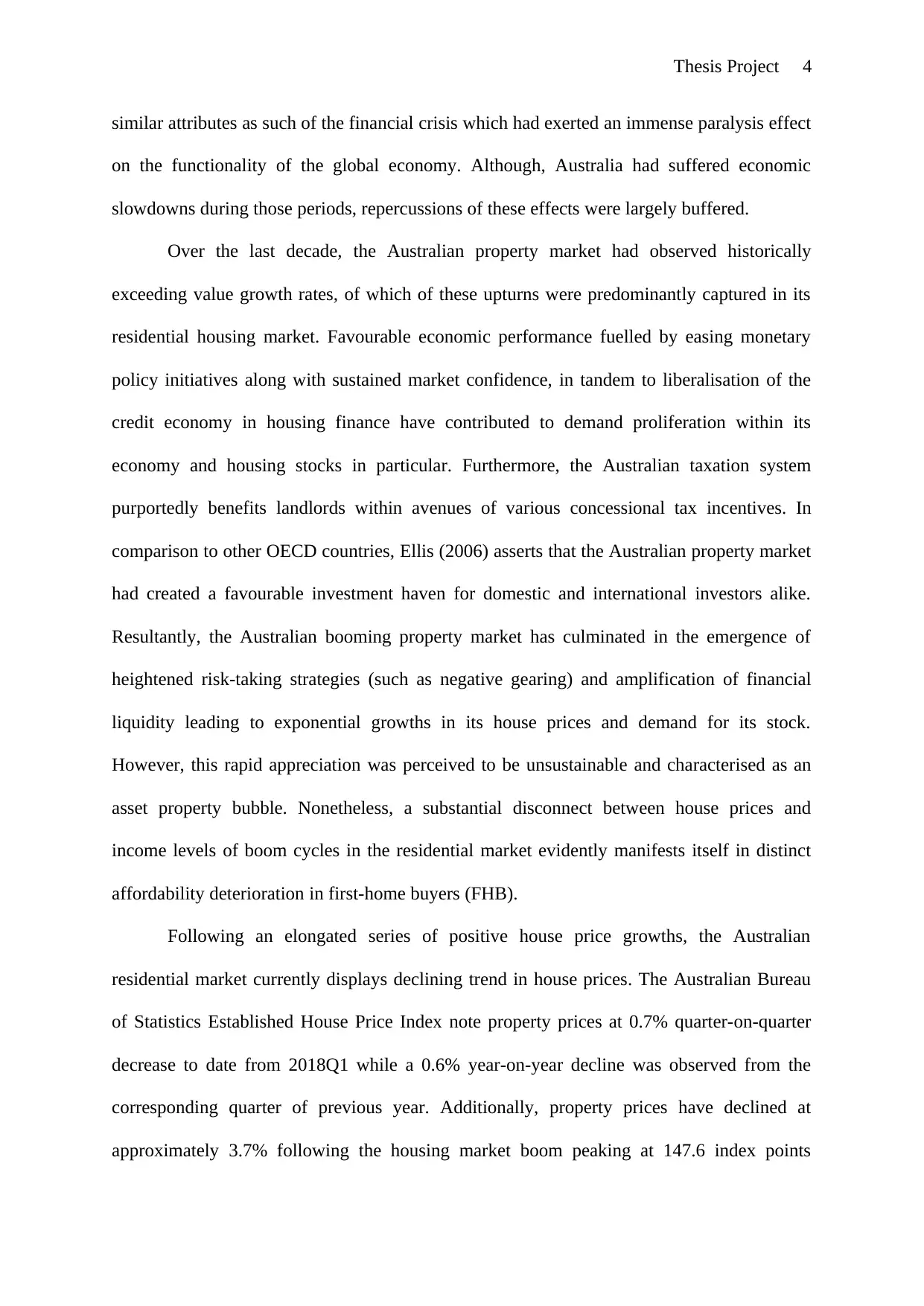
Thesis Project 4
similar attributes as such of the financial crisis which had exerted an immense paralysis effect
on the functionality of the global economy. Although, Australia had suffered economic
slowdowns during those periods, repercussions of these effects were largely buffered.
Over the last decade, the Australian property market had observed historically
exceeding value growth rates, of which of these upturns were predominantly captured in its
residential housing market. Favourable economic performance fuelled by easing monetary
policy initiatives along with sustained market confidence, in tandem to liberalisation of the
credit economy in housing finance have contributed to demand proliferation within its
economy and housing stocks in particular. Furthermore, the Australian taxation system
purportedly benefits landlords within avenues of various concessional tax incentives. In
comparison to other OECD countries, Ellis (2006) asserts that the Australian property market
had created a favourable investment haven for domestic and international investors alike.
Resultantly, the Australian booming property market has culminated in the emergence of
heightened risk-taking strategies (such as negative gearing) and amplification of financial
liquidity leading to exponential growths in its house prices and demand for its stock.
However, this rapid appreciation was perceived to be unsustainable and characterised as an
asset property bubble. Nonetheless, a substantial disconnect between house prices and
income levels of boom cycles in the residential market evidently manifests itself in distinct
affordability deterioration in first-home buyers (FHB).
Following an elongated series of positive house price growths, the Australian
residential market currently displays declining trend in house prices. The Australian Bureau
of Statistics Established House Price Index note property prices at 0.7% quarter-on-quarter
decrease to date from 2018Q1 while a 0.6% year-on-year decline was observed from the
corresponding quarter of previous year. Additionally, property prices have declined at
approximately 3.7% following the housing market boom peaking at 147.6 index points
similar attributes as such of the financial crisis which had exerted an immense paralysis effect
on the functionality of the global economy. Although, Australia had suffered economic
slowdowns during those periods, repercussions of these effects were largely buffered.
Over the last decade, the Australian property market had observed historically
exceeding value growth rates, of which of these upturns were predominantly captured in its
residential housing market. Favourable economic performance fuelled by easing monetary
policy initiatives along with sustained market confidence, in tandem to liberalisation of the
credit economy in housing finance have contributed to demand proliferation within its
economy and housing stocks in particular. Furthermore, the Australian taxation system
purportedly benefits landlords within avenues of various concessional tax incentives. In
comparison to other OECD countries, Ellis (2006) asserts that the Australian property market
had created a favourable investment haven for domestic and international investors alike.
Resultantly, the Australian booming property market has culminated in the emergence of
heightened risk-taking strategies (such as negative gearing) and amplification of financial
liquidity leading to exponential growths in its house prices and demand for its stock.
However, this rapid appreciation was perceived to be unsustainable and characterised as an
asset property bubble. Nonetheless, a substantial disconnect between house prices and
income levels of boom cycles in the residential market evidently manifests itself in distinct
affordability deterioration in first-home buyers (FHB).
Following an elongated series of positive house price growths, the Australian
residential market currently displays declining trend in house prices. The Australian Bureau
of Statistics Established House Price Index note property prices at 0.7% quarter-on-quarter
decrease to date from 2018Q1 while a 0.6% year-on-year decline was observed from the
corresponding quarter of previous year. Additionally, property prices have declined at
approximately 3.7% following the housing market boom peaking at 147.6 index points
Paraphrase This Document
Need a fresh take? Get an instant paraphrase of this document with our AI Paraphraser
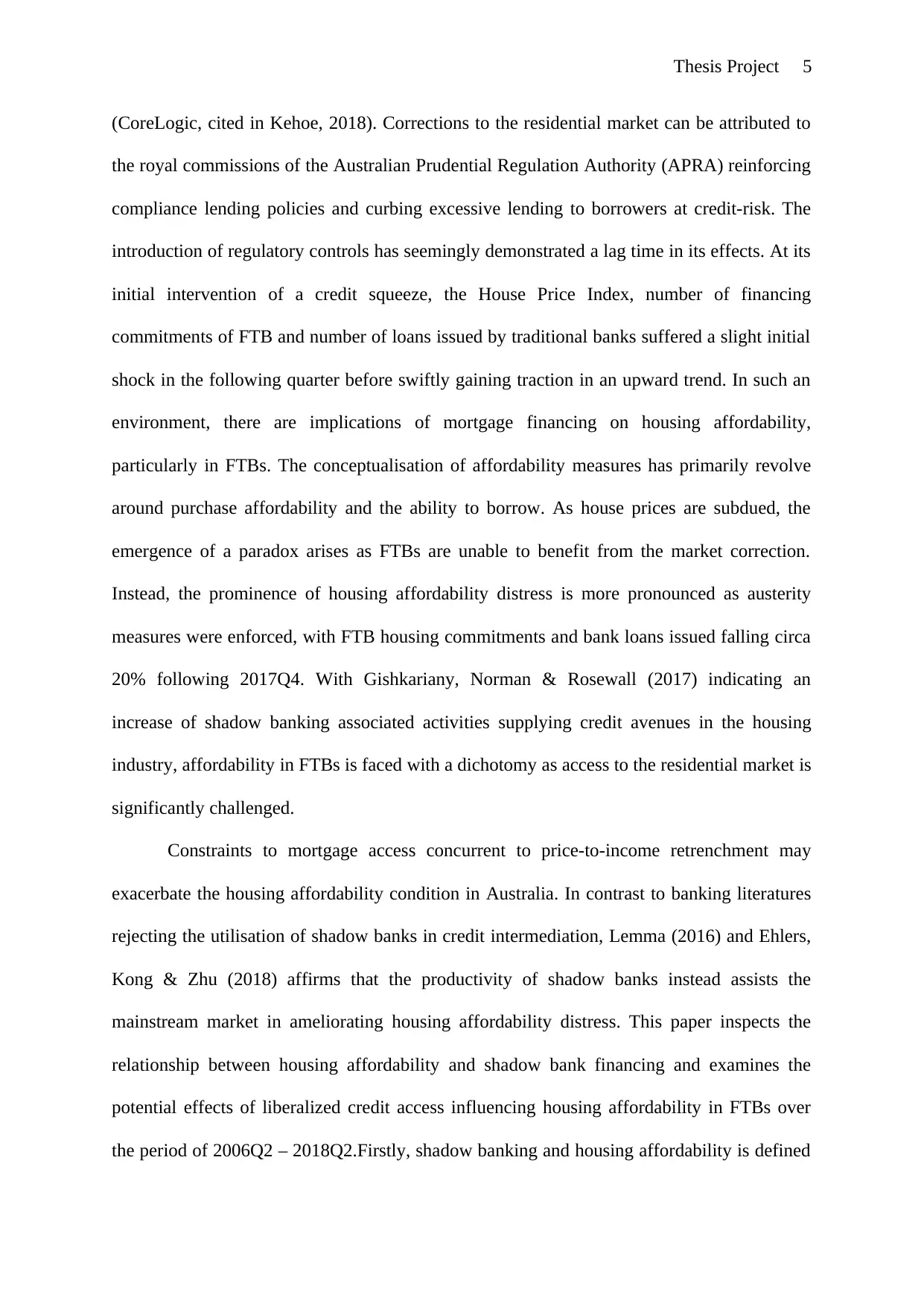
Thesis Project 5
(CoreLogic, cited in Kehoe, 2018). Corrections to the residential market can be attributed to
the royal commissions of the Australian Prudential Regulation Authority (APRA) reinforcing
compliance lending policies and curbing excessive lending to borrowers at credit-risk. The
introduction of regulatory controls has seemingly demonstrated a lag time in its effects. At its
initial intervention of a credit squeeze, the House Price Index, number of financing
commitments of FTB and number of loans issued by traditional banks suffered a slight initial
shock in the following quarter before swiftly gaining traction in an upward trend. In such an
environment, there are implications of mortgage financing on housing affordability,
particularly in FTBs. The conceptualisation of affordability measures has primarily revolve
around purchase affordability and the ability to borrow. As house prices are subdued, the
emergence of a paradox arises as FTBs are unable to benefit from the market correction.
Instead, the prominence of housing affordability distress is more pronounced as austerity
measures were enforced, with FTB housing commitments and bank loans issued falling circa
20% following 2017Q4. With Gishkariany, Norman & Rosewall (2017) indicating an
increase of shadow banking associated activities supplying credit avenues in the housing
industry, affordability in FTBs is faced with a dichotomy as access to the residential market is
significantly challenged.
Constraints to mortgage access concurrent to price-to-income retrenchment may
exacerbate the housing affordability condition in Australia. In contrast to banking literatures
rejecting the utilisation of shadow banks in credit intermediation, Lemma (2016) and Ehlers,
Kong & Zhu (2018) affirms that the productivity of shadow banks instead assists the
mainstream market in ameliorating housing affordability distress. This paper inspects the
relationship between housing affordability and shadow bank financing and examines the
potential effects of liberalized credit access influencing housing affordability in FTBs over
the period of 2006Q2 – 2018Q2.Firstly, shadow banking and housing affordability is defined
(CoreLogic, cited in Kehoe, 2018). Corrections to the residential market can be attributed to
the royal commissions of the Australian Prudential Regulation Authority (APRA) reinforcing
compliance lending policies and curbing excessive lending to borrowers at credit-risk. The
introduction of regulatory controls has seemingly demonstrated a lag time in its effects. At its
initial intervention of a credit squeeze, the House Price Index, number of financing
commitments of FTB and number of loans issued by traditional banks suffered a slight initial
shock in the following quarter before swiftly gaining traction in an upward trend. In such an
environment, there are implications of mortgage financing on housing affordability,
particularly in FTBs. The conceptualisation of affordability measures has primarily revolve
around purchase affordability and the ability to borrow. As house prices are subdued, the
emergence of a paradox arises as FTBs are unable to benefit from the market correction.
Instead, the prominence of housing affordability distress is more pronounced as austerity
measures were enforced, with FTB housing commitments and bank loans issued falling circa
20% following 2017Q4. With Gishkariany, Norman & Rosewall (2017) indicating an
increase of shadow banking associated activities supplying credit avenues in the housing
industry, affordability in FTBs is faced with a dichotomy as access to the residential market is
significantly challenged.
Constraints to mortgage access concurrent to price-to-income retrenchment may
exacerbate the housing affordability condition in Australia. In contrast to banking literatures
rejecting the utilisation of shadow banks in credit intermediation, Lemma (2016) and Ehlers,
Kong & Zhu (2018) affirms that the productivity of shadow banks instead assists the
mainstream market in ameliorating housing affordability distress. This paper inspects the
relationship between housing affordability and shadow bank financing and examines the
potential effects of liberalized credit access influencing housing affordability in FTBs over
the period of 2006Q2 – 2018Q2.Firstly, shadow banking and housing affordability is defined
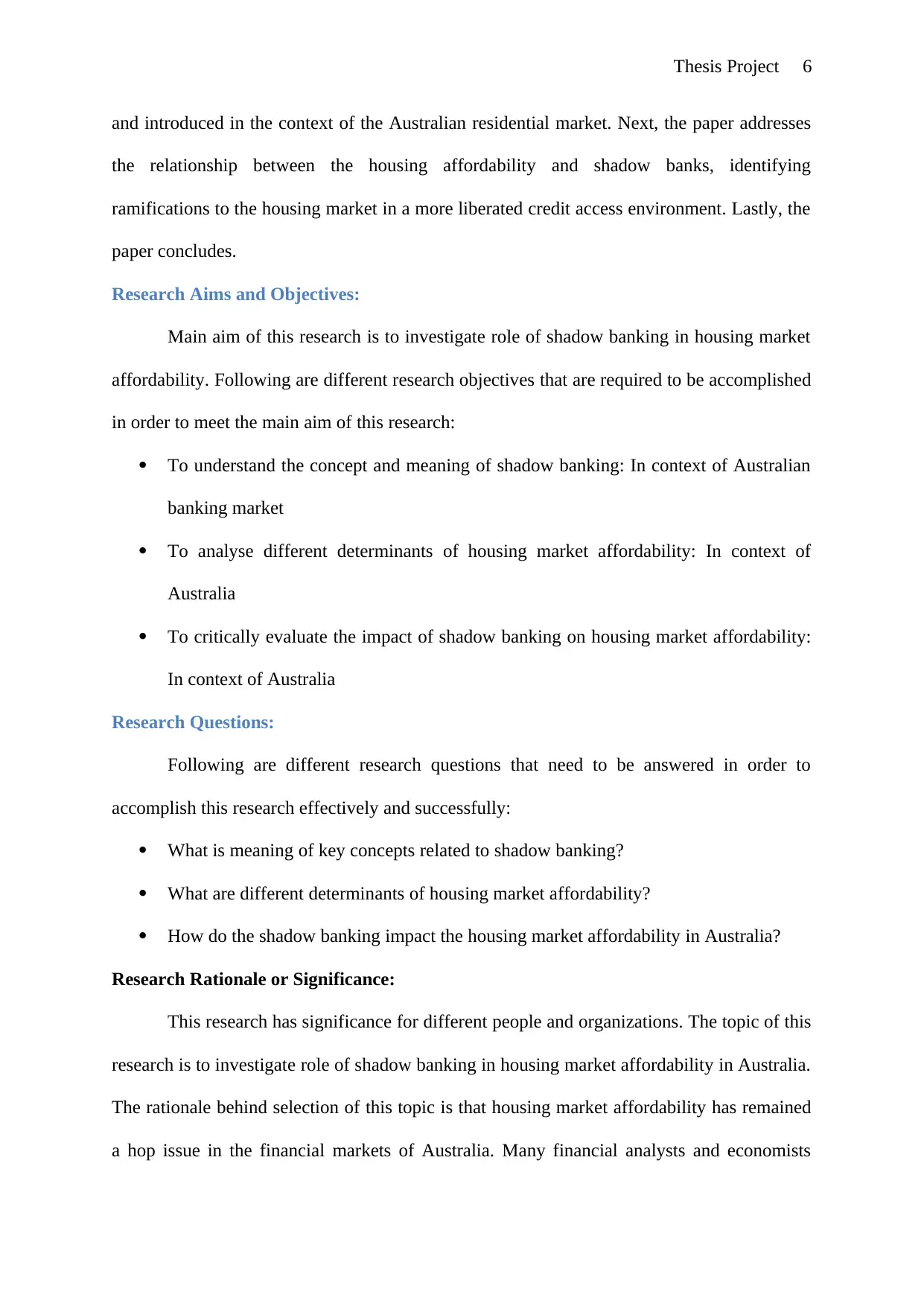
Thesis Project 6
and introduced in the context of the Australian residential market. Next, the paper addresses
the relationship between the housing affordability and shadow banks, identifying
ramifications to the housing market in a more liberated credit access environment. Lastly, the
paper concludes.
Research Aims and Objectives:
Main aim of this research is to investigate role of shadow banking in housing market
affordability. Following are different research objectives that are required to be accomplished
in order to meet the main aim of this research:
To understand the concept and meaning of shadow banking: In context of Australian
banking market
To analyse different determinants of housing market affordability: In context of
Australia
To critically evaluate the impact of shadow banking on housing market affordability:
In context of Australia
Research Questions:
Following are different research questions that need to be answered in order to
accomplish this research effectively and successfully:
What is meaning of key concepts related to shadow banking?
What are different determinants of housing market affordability?
How do the shadow banking impact the housing market affordability in Australia?
Research Rationale or Significance:
This research has significance for different people and organizations. The topic of this
research is to investigate role of shadow banking in housing market affordability in Australia.
The rationale behind selection of this topic is that housing market affordability has remained
a hop issue in the financial markets of Australia. Many financial analysts and economists
and introduced in the context of the Australian residential market. Next, the paper addresses
the relationship between the housing affordability and shadow banks, identifying
ramifications to the housing market in a more liberated credit access environment. Lastly, the
paper concludes.
Research Aims and Objectives:
Main aim of this research is to investigate role of shadow banking in housing market
affordability. Following are different research objectives that are required to be accomplished
in order to meet the main aim of this research:
To understand the concept and meaning of shadow banking: In context of Australian
banking market
To analyse different determinants of housing market affordability: In context of
Australia
To critically evaluate the impact of shadow banking on housing market affordability:
In context of Australia
Research Questions:
Following are different research questions that need to be answered in order to
accomplish this research effectively and successfully:
What is meaning of key concepts related to shadow banking?
What are different determinants of housing market affordability?
How do the shadow banking impact the housing market affordability in Australia?
Research Rationale or Significance:
This research has significance for different people and organizations. The topic of this
research is to investigate role of shadow banking in housing market affordability in Australia.
The rationale behind selection of this topic is that housing market affordability has remained
a hop issue in the financial markets of Australia. Many financial analysts and economists
⊘ This is a preview!⊘
Do you want full access?
Subscribe today to unlock all pages.

Trusted by 1+ million students worldwide
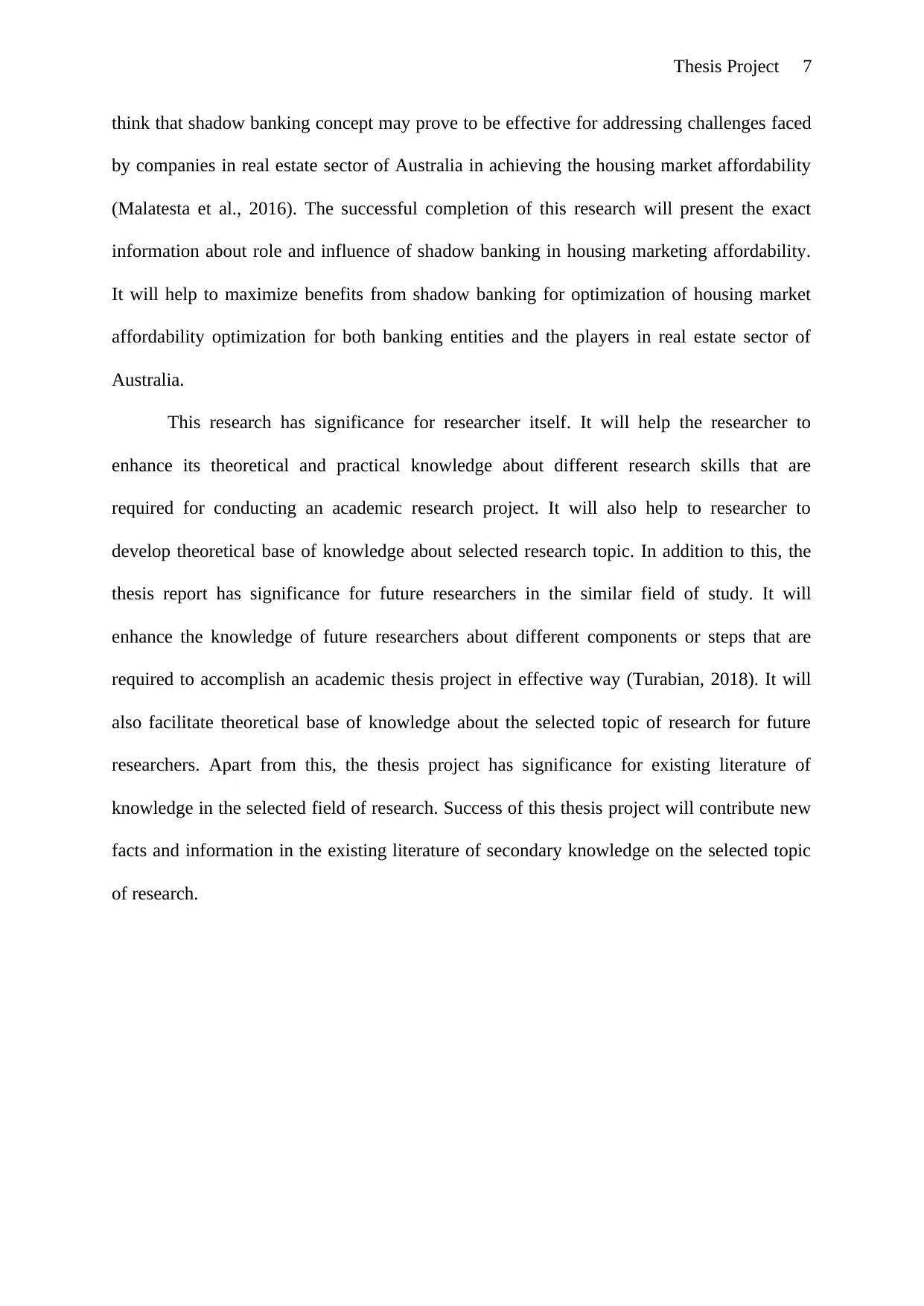
Thesis Project 7
think that shadow banking concept may prove to be effective for addressing challenges faced
by companies in real estate sector of Australia in achieving the housing market affordability
(Malatesta et al., 2016). The successful completion of this research will present the exact
information about role and influence of shadow banking in housing marketing affordability.
It will help to maximize benefits from shadow banking for optimization of housing market
affordability optimization for both banking entities and the players in real estate sector of
Australia.
This research has significance for researcher itself. It will help the researcher to
enhance its theoretical and practical knowledge about different research skills that are
required for conducting an academic research project. It will also help to researcher to
develop theoretical base of knowledge about selected research topic. In addition to this, the
thesis report has significance for future researchers in the similar field of study. It will
enhance the knowledge of future researchers about different components or steps that are
required to accomplish an academic thesis project in effective way (Turabian, 2018). It will
also facilitate theoretical base of knowledge about the selected topic of research for future
researchers. Apart from this, the thesis project has significance for existing literature of
knowledge in the selected field of research. Success of this thesis project will contribute new
facts and information in the existing literature of secondary knowledge on the selected topic
of research.
think that shadow banking concept may prove to be effective for addressing challenges faced
by companies in real estate sector of Australia in achieving the housing market affordability
(Malatesta et al., 2016). The successful completion of this research will present the exact
information about role and influence of shadow banking in housing marketing affordability.
It will help to maximize benefits from shadow banking for optimization of housing market
affordability optimization for both banking entities and the players in real estate sector of
Australia.
This research has significance for researcher itself. It will help the researcher to
enhance its theoretical and practical knowledge about different research skills that are
required for conducting an academic research project. It will also help to researcher to
develop theoretical base of knowledge about selected research topic. In addition to this, the
thesis report has significance for future researchers in the similar field of study. It will
enhance the knowledge of future researchers about different components or steps that are
required to accomplish an academic thesis project in effective way (Turabian, 2018). It will
also facilitate theoretical base of knowledge about the selected topic of research for future
researchers. Apart from this, the thesis project has significance for existing literature of
knowledge in the selected field of research. Success of this thesis project will contribute new
facts and information in the existing literature of secondary knowledge on the selected topic
of research.
Paraphrase This Document
Need a fresh take? Get an instant paraphrase of this document with our AI Paraphraser
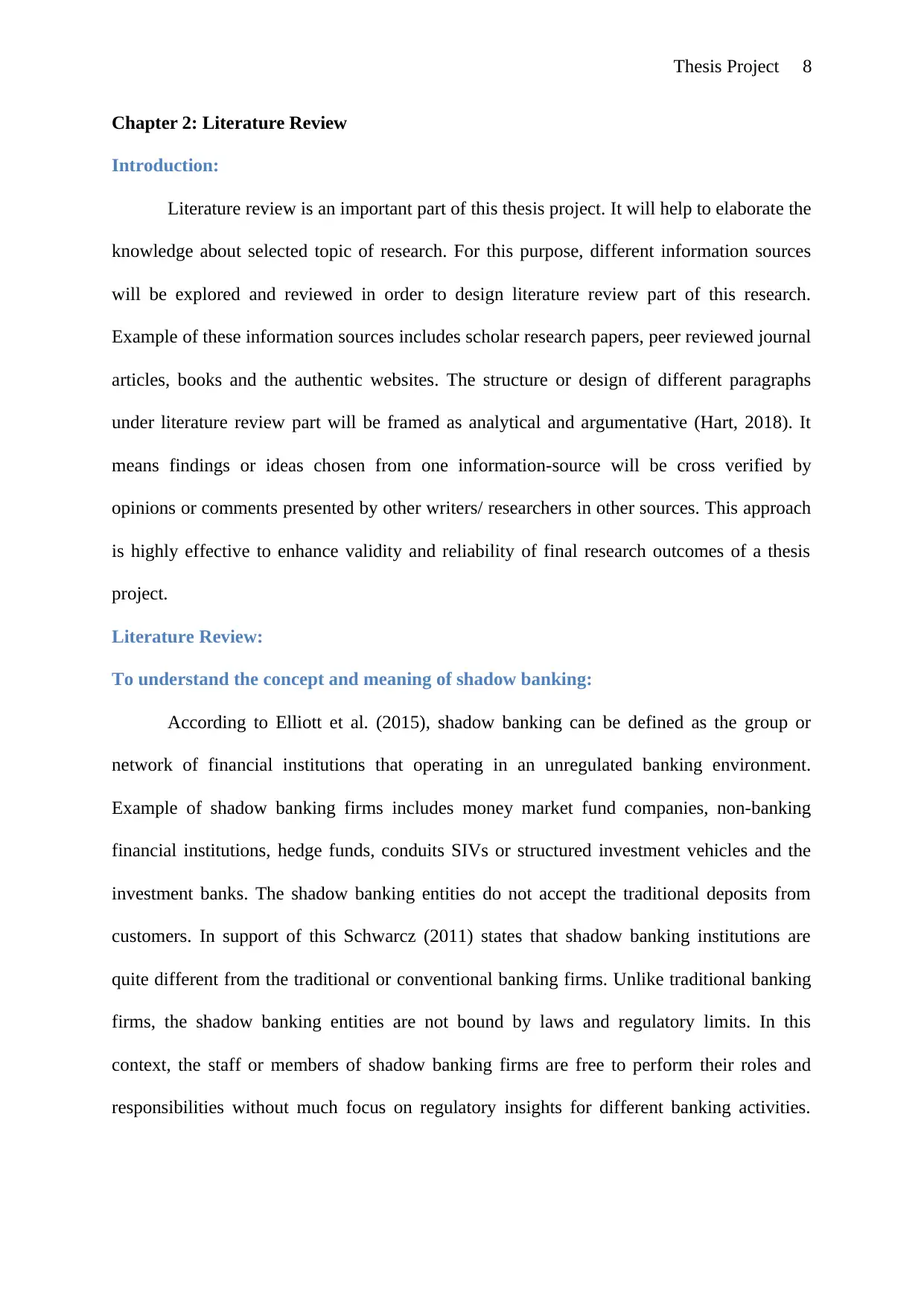
Thesis Project 8
Chapter 2: Literature Review
Introduction:
Literature review is an important part of this thesis project. It will help to elaborate the
knowledge about selected topic of research. For this purpose, different information sources
will be explored and reviewed in order to design literature review part of this research.
Example of these information sources includes scholar research papers, peer reviewed journal
articles, books and the authentic websites. The structure or design of different paragraphs
under literature review part will be framed as analytical and argumentative (Hart, 2018). It
means findings or ideas chosen from one information-source will be cross verified by
opinions or comments presented by other writers/ researchers in other sources. This approach
is highly effective to enhance validity and reliability of final research outcomes of a thesis
project.
Literature Review:
To understand the concept and meaning of shadow banking:
According to Elliott et al. (2015), shadow banking can be defined as the group or
network of financial institutions that operating in an unregulated banking environment.
Example of shadow banking firms includes money market fund companies, non-banking
financial institutions, hedge funds, conduits SIVs or structured investment vehicles and the
investment banks. The shadow banking entities do not accept the traditional deposits from
customers. In support of this Schwarcz (2011) states that shadow banking institutions are
quite different from the traditional or conventional banking firms. Unlike traditional banking
firms, the shadow banking entities are not bound by laws and regulatory limits. In this
context, the staff or members of shadow banking firms are free to perform their roles and
responsibilities without much focus on regulatory insights for different banking activities.
Chapter 2: Literature Review
Introduction:
Literature review is an important part of this thesis project. It will help to elaborate the
knowledge about selected topic of research. For this purpose, different information sources
will be explored and reviewed in order to design literature review part of this research.
Example of these information sources includes scholar research papers, peer reviewed journal
articles, books and the authentic websites. The structure or design of different paragraphs
under literature review part will be framed as analytical and argumentative (Hart, 2018). It
means findings or ideas chosen from one information-source will be cross verified by
opinions or comments presented by other writers/ researchers in other sources. This approach
is highly effective to enhance validity and reliability of final research outcomes of a thesis
project.
Literature Review:
To understand the concept and meaning of shadow banking:
According to Elliott et al. (2015), shadow banking can be defined as the group or
network of financial institutions that operating in an unregulated banking environment.
Example of shadow banking firms includes money market fund companies, non-banking
financial institutions, hedge funds, conduits SIVs or structured investment vehicles and the
investment banks. The shadow banking entities do not accept the traditional deposits from
customers. In support of this Schwarcz (2011) states that shadow banking institutions are
quite different from the traditional or conventional banking firms. Unlike traditional banking
firms, the shadow banking entities are not bound by laws and regulatory limits. In this
context, the staff or members of shadow banking firms are free to perform their roles and
responsibilities without much focus on regulatory insights for different banking activities.
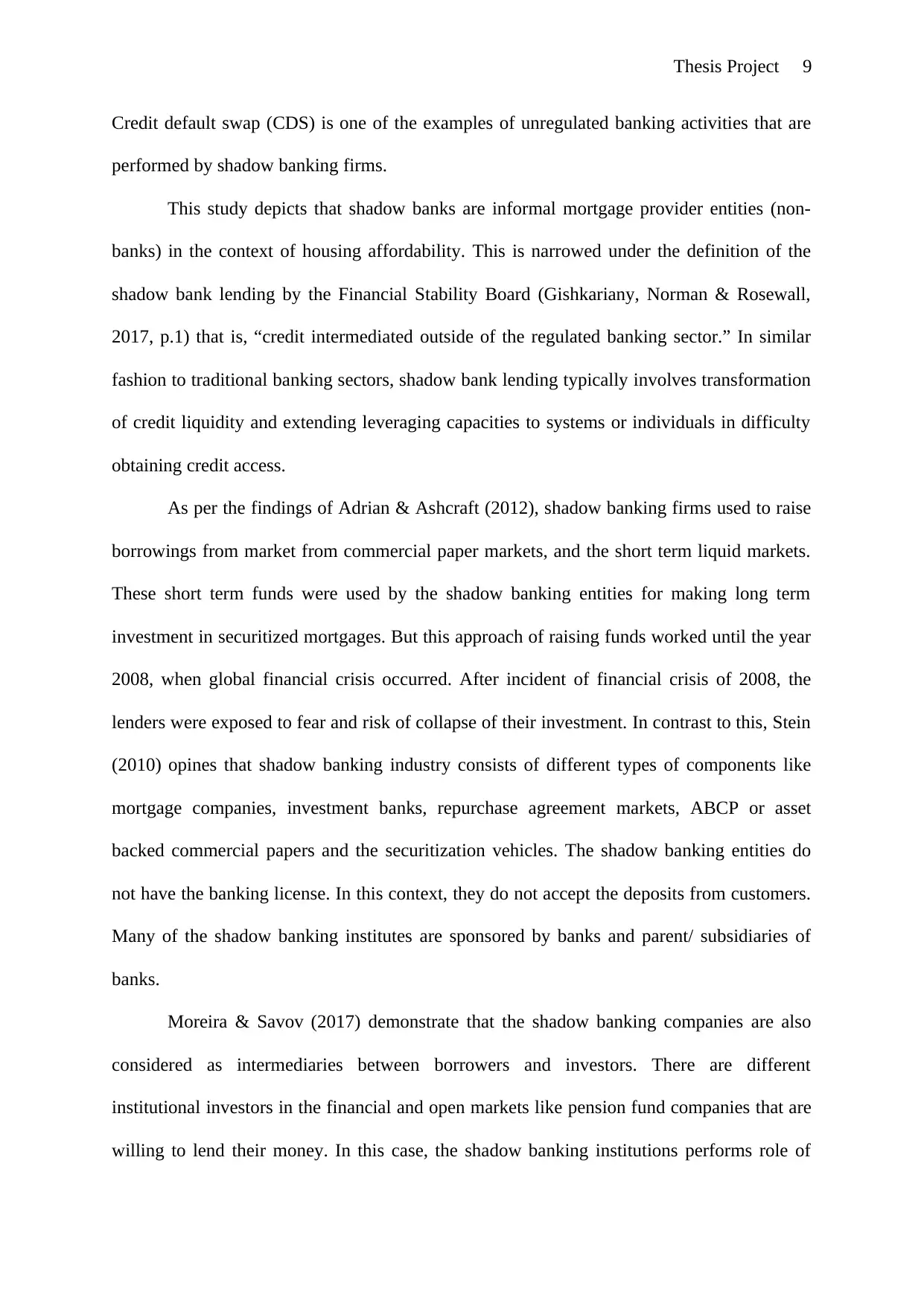
Thesis Project 9
Credit default swap (CDS) is one of the examples of unregulated banking activities that are
performed by shadow banking firms.
This study depicts that shadow banks are informal mortgage provider entities (non-
banks) in the context of housing affordability. This is narrowed under the definition of the
shadow bank lending by the Financial Stability Board (Gishkariany, Norman & Rosewall,
2017, p.1) that is, “credit intermediated outside of the regulated banking sector.” In similar
fashion to traditional banking sectors, shadow bank lending typically involves transformation
of credit liquidity and extending leveraging capacities to systems or individuals in difficulty
obtaining credit access.
As per the findings of Adrian & Ashcraft (2012), shadow banking firms used to raise
borrowings from market from commercial paper markets, and the short term liquid markets.
These short term funds were used by the shadow banking entities for making long term
investment in securitized mortgages. But this approach of raising funds worked until the year
2008, when global financial crisis occurred. After incident of financial crisis of 2008, the
lenders were exposed to fear and risk of collapse of their investment. In contrast to this, Stein
(2010) opines that shadow banking industry consists of different types of components like
mortgage companies, investment banks, repurchase agreement markets, ABCP or asset
backed commercial papers and the securitization vehicles. The shadow banking entities do
not have the banking license. In this context, they do not accept the deposits from customers.
Many of the shadow banking institutes are sponsored by banks and parent/ subsidiaries of
banks.
Moreira & Savov (2017) demonstrate that the shadow banking companies are also
considered as intermediaries between borrowers and investors. There are different
institutional investors in the financial and open markets like pension fund companies that are
willing to lend their money. In this case, the shadow banking institutions performs role of
Credit default swap (CDS) is one of the examples of unregulated banking activities that are
performed by shadow banking firms.
This study depicts that shadow banks are informal mortgage provider entities (non-
banks) in the context of housing affordability. This is narrowed under the definition of the
shadow bank lending by the Financial Stability Board (Gishkariany, Norman & Rosewall,
2017, p.1) that is, “credit intermediated outside of the regulated banking sector.” In similar
fashion to traditional banking sectors, shadow bank lending typically involves transformation
of credit liquidity and extending leveraging capacities to systems or individuals in difficulty
obtaining credit access.
As per the findings of Adrian & Ashcraft (2012), shadow banking firms used to raise
borrowings from market from commercial paper markets, and the short term liquid markets.
These short term funds were used by the shadow banking entities for making long term
investment in securitized mortgages. But this approach of raising funds worked until the year
2008, when global financial crisis occurred. After incident of financial crisis of 2008, the
lenders were exposed to fear and risk of collapse of their investment. In contrast to this, Stein
(2010) opines that shadow banking industry consists of different types of components like
mortgage companies, investment banks, repurchase agreement markets, ABCP or asset
backed commercial papers and the securitization vehicles. The shadow banking entities do
not have the banking license. In this context, they do not accept the deposits from customers.
Many of the shadow banking institutes are sponsored by banks and parent/ subsidiaries of
banks.
Moreira & Savov (2017) demonstrate that the shadow banking companies are also
considered as intermediaries between borrowers and investors. There are different
institutional investors in the financial and open markets like pension fund companies that are
willing to lend their money. In this case, the shadow banking institutions performs role of
⊘ This is a preview!⊘
Do you want full access?
Subscribe today to unlock all pages.

Trusted by 1+ million students worldwide

Thesis Project 10
channel, which makes flow of money from investors to corporations in the need of capital.
The profit of shadow banking firms if the difference amount of money paid by them to
investors (as interest on their money) and the interest received by them from corporations. At
the same time, Gennaioli et al. (2013) articulate that the shadow banking institutions are
highly exposed to liquidity risk, credit risk and market risk. It is so because the liabilities of
shadow banking firms are short term in nature and the assets are illiquidity and long term in
nature. In addition to this, there is no any source of deposits from customers, as in case of
traditional banking firms. There is also no support to these firms (i.e. shadow banking
institutions) from central bank in the country. Due to these situations, in case of adverse
market periods, the risk of bankruptcy increases with the shadow banking firms.
The emergence of shadow bank financing had been widely documented. For example,
Gabor (2013) and Gishkariany, Norman & Rosewall (2017) observed that policy reforms
pertaining to increased regulatory oversight had resulted in increased shadow banking
activities in the lending market. Restriction to conventional credit access creates a demand
vacuum in the lending market. As such, shadow banks usually respond to this demand, thus
resulting in growth in non-banks. Where there is greater reliance on gaining mortgage access
from principal lending entities, the greater the substitution effect was found in the growth of
non-banks as macro prudential policies restricts credit access (Morris-Levenson, Sarama &
Ungerer, 2017). Prior to the implementation of regulatory reforms in 2014 by the APRA,
financial policies in concert with a liberalized credit economy had shifted housing policies
towards pro-homeownership.
Housing polices such as fiscal incentives and unconstrained mortgage access into the
residential market has had significant impacts in the property market. Similarly, Ortalo-
Magne & Rady (2002) demonstrated that institutional reforms promoting owner-occupation
rates had resulted in the proliferation of housing demand. Evidently, house prices in Australia
channel, which makes flow of money from investors to corporations in the need of capital.
The profit of shadow banking firms if the difference amount of money paid by them to
investors (as interest on their money) and the interest received by them from corporations. At
the same time, Gennaioli et al. (2013) articulate that the shadow banking institutions are
highly exposed to liquidity risk, credit risk and market risk. It is so because the liabilities of
shadow banking firms are short term in nature and the assets are illiquidity and long term in
nature. In addition to this, there is no any source of deposits from customers, as in case of
traditional banking firms. There is also no support to these firms (i.e. shadow banking
institutions) from central bank in the country. Due to these situations, in case of adverse
market periods, the risk of bankruptcy increases with the shadow banking firms.
The emergence of shadow bank financing had been widely documented. For example,
Gabor (2013) and Gishkariany, Norman & Rosewall (2017) observed that policy reforms
pertaining to increased regulatory oversight had resulted in increased shadow banking
activities in the lending market. Restriction to conventional credit access creates a demand
vacuum in the lending market. As such, shadow banks usually respond to this demand, thus
resulting in growth in non-banks. Where there is greater reliance on gaining mortgage access
from principal lending entities, the greater the substitution effect was found in the growth of
non-banks as macro prudential policies restricts credit access (Morris-Levenson, Sarama &
Ungerer, 2017). Prior to the implementation of regulatory reforms in 2014 by the APRA,
financial policies in concert with a liberalized credit economy had shifted housing policies
towards pro-homeownership.
Housing polices such as fiscal incentives and unconstrained mortgage access into the
residential market has had significant impacts in the property market. Similarly, Ortalo-
Magne & Rady (2002) demonstrated that institutional reforms promoting owner-occupation
rates had resulted in the proliferation of housing demand. Evidently, house prices in Australia
Paraphrase This Document
Need a fresh take? Get an instant paraphrase of this document with our AI Paraphraser

Thesis Project 11
had experienced exponential growth. In Davis & Zhu (2004), they observed that an easing
credit access environment had a self-reinforcing positive feedback loop in market demand
and liquidity within the mortgage market. Consequently, the supply of ‘cheap’ credit was
constantly supplied back into the market, thus sustaining a boom market. This particular
aspect manifests within the Australian residential market, with consistent upward trending
house prices. However, there is a widespread concern for such unsustainable price growths
forming a price bubble, thus amplifying volatility within the residential market. Nonetheless,
a deregulated lending market had positive impacts on alleviating credit constrained
households. Campbell & Cocco’s (2003) study revealed that diminished credit restrictions
had improved the demand for housing. This signifies a positive relationship in house price
increases and deregulations in the lending market.
This observation was sustained by Duca, Muelbauer & Murphy (2011) affirming that
informal lender entities dynamically extends credit availability as market price increases, in
particular to FTBs. The introduction of shadow bank financing dynamics into the regular
lending system creates alternative avenues for credit, which leads to greater credit supply and
competition amongst lenders. According to Girouard, Kennedy & Andre (2006), a dramatic
increase in homeownership rates was observed amongst lower-income demographics,
especially FTBs as supply-side innovations utilises international mortgage markets.
Following fundamental economic truism, in face of competition non-banks lower costs to
consumers, thus improving efficiency within the mortgage system (Scanlon, Lunde, &
Whitehead, 2008).
To analyse different determinants of housing market affordability:
In the views of Pierse et al. (2016), housing market can be defined as the group of
companies that are involved in developing and selling the commercial and residential
properties. In other words, the housing market is also known as real estate and construction
had experienced exponential growth. In Davis & Zhu (2004), they observed that an easing
credit access environment had a self-reinforcing positive feedback loop in market demand
and liquidity within the mortgage market. Consequently, the supply of ‘cheap’ credit was
constantly supplied back into the market, thus sustaining a boom market. This particular
aspect manifests within the Australian residential market, with consistent upward trending
house prices. However, there is a widespread concern for such unsustainable price growths
forming a price bubble, thus amplifying volatility within the residential market. Nonetheless,
a deregulated lending market had positive impacts on alleviating credit constrained
households. Campbell & Cocco’s (2003) study revealed that diminished credit restrictions
had improved the demand for housing. This signifies a positive relationship in house price
increases and deregulations in the lending market.
This observation was sustained by Duca, Muelbauer & Murphy (2011) affirming that
informal lender entities dynamically extends credit availability as market price increases, in
particular to FTBs. The introduction of shadow bank financing dynamics into the regular
lending system creates alternative avenues for credit, which leads to greater credit supply and
competition amongst lenders. According to Girouard, Kennedy & Andre (2006), a dramatic
increase in homeownership rates was observed amongst lower-income demographics,
especially FTBs as supply-side innovations utilises international mortgage markets.
Following fundamental economic truism, in face of competition non-banks lower costs to
consumers, thus improving efficiency within the mortgage system (Scanlon, Lunde, &
Whitehead, 2008).
To analyse different determinants of housing market affordability:
In the views of Pierse et al. (2016), housing market can be defined as the group of
companies that are involved in developing and selling the commercial and residential
properties. In other words, the housing market is also known as real estate and construction
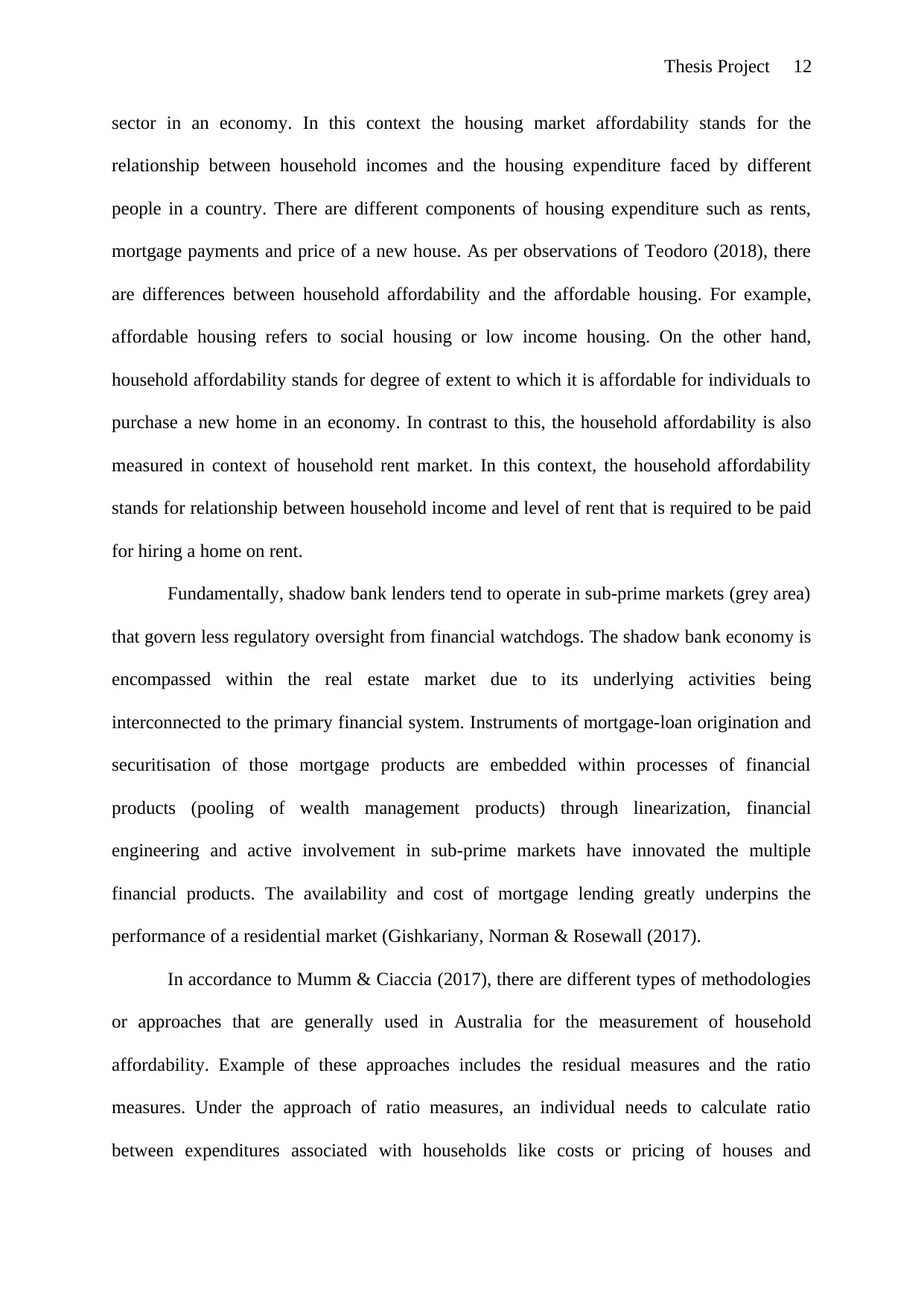
Thesis Project 12
sector in an economy. In this context the housing market affordability stands for the
relationship between household incomes and the housing expenditure faced by different
people in a country. There are different components of housing expenditure such as rents,
mortgage payments and price of a new house. As per observations of Teodoro (2018), there
are differences between household affordability and the affordable housing. For example,
affordable housing refers to social housing or low income housing. On the other hand,
household affordability stands for degree of extent to which it is affordable for individuals to
purchase a new home in an economy. In contrast to this, the household affordability is also
measured in context of household rent market. In this context, the household affordability
stands for relationship between household income and level of rent that is required to be paid
for hiring a home on rent.
Fundamentally, shadow bank lenders tend to operate in sub-prime markets (grey area)
that govern less regulatory oversight from financial watchdogs. The shadow bank economy is
encompassed within the real estate market due to its underlying activities being
interconnected to the primary financial system. Instruments of mortgage-loan origination and
securitisation of those mortgage products are embedded within processes of financial
products (pooling of wealth management products) through linearization, financial
engineering and active involvement in sub-prime markets have innovated the multiple
financial products. The availability and cost of mortgage lending greatly underpins the
performance of a residential market (Gishkariany, Norman & Rosewall (2017).
In accordance to Mumm & Ciaccia (2017), there are different types of methodologies
or approaches that are generally used in Australia for the measurement of household
affordability. Example of these approaches includes the residual measures and the ratio
measures. Under the approach of ratio measures, an individual needs to calculate ratio
between expenditures associated with households like costs or pricing of houses and
sector in an economy. In this context the housing market affordability stands for the
relationship between household incomes and the housing expenditure faced by different
people in a country. There are different components of housing expenditure such as rents,
mortgage payments and price of a new house. As per observations of Teodoro (2018), there
are differences between household affordability and the affordable housing. For example,
affordable housing refers to social housing or low income housing. On the other hand,
household affordability stands for degree of extent to which it is affordable for individuals to
purchase a new home in an economy. In contrast to this, the household affordability is also
measured in context of household rent market. In this context, the household affordability
stands for relationship between household income and level of rent that is required to be paid
for hiring a home on rent.
Fundamentally, shadow bank lenders tend to operate in sub-prime markets (grey area)
that govern less regulatory oversight from financial watchdogs. The shadow bank economy is
encompassed within the real estate market due to its underlying activities being
interconnected to the primary financial system. Instruments of mortgage-loan origination and
securitisation of those mortgage products are embedded within processes of financial
products (pooling of wealth management products) through linearization, financial
engineering and active involvement in sub-prime markets have innovated the multiple
financial products. The availability and cost of mortgage lending greatly underpins the
performance of a residential market (Gishkariany, Norman & Rosewall (2017).
In accordance to Mumm & Ciaccia (2017), there are different types of methodologies
or approaches that are generally used in Australia for the measurement of household
affordability. Example of these approaches includes the residual measures and the ratio
measures. Under the approach of ratio measures, an individual needs to calculate ratio
between expenditures associated with households like costs or pricing of houses and
⊘ This is a preview!⊘
Do you want full access?
Subscribe today to unlock all pages.

Trusted by 1+ million students worldwide
1 out of 33
Related Documents
Your All-in-One AI-Powered Toolkit for Academic Success.
+13062052269
info@desklib.com
Available 24*7 on WhatsApp / Email
![[object Object]](/_next/static/media/star-bottom.7253800d.svg)
Unlock your academic potential
Copyright © 2020–2025 A2Z Services. All Rights Reserved. Developed and managed by ZUCOL.





